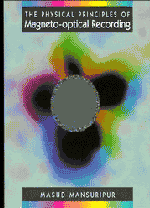Book contents
- Frontmatter
- Contents
- Preface
- 1 Overview of Optical Data Storage
- 2 Optics of Gaussian Beams
- 3 Theory of Diffraction
- 4 Diffraction of Gaussian Beams from Sharp Edges
- 5 Optics of Thin Films and Multilayers
- 6 Magneto-optical Readout
- 7 Effects of High-numerical-aperture Focusing on the State of Polarization
- 8 Computer Modeling of the Optical Path
- 9 Noise in Magneto-optical Readout
- 10 Modulation Coding and Error Correction
- 11 Thermal Aspects of Magneto-optical Recording
- 12 Fundamentals of Magnetism and Magnetic Materials
- 13 Magnetostatics of Thin-film Magneto-optical Media
- 14 Mean-field Analysis of Amorphous Rare Earth–Transition Metal Alloys
- 15 Magnetization Dynamics
- 16 Origins of Coercivity
- 17 The Process of Thermomagnetic Recording
- 18 Media Characterization
- References
- Index
8 - Computer Modeling of the Optical Path
Published online by Cambridge University Press: 07 September 2010
- Frontmatter
- Contents
- Preface
- 1 Overview of Optical Data Storage
- 2 Optics of Gaussian Beams
- 3 Theory of Diffraction
- 4 Diffraction of Gaussian Beams from Sharp Edges
- 5 Optics of Thin Films and Multilayers
- 6 Magneto-optical Readout
- 7 Effects of High-numerical-aperture Focusing on the State of Polarization
- 8 Computer Modeling of the Optical Path
- 9 Noise in Magneto-optical Readout
- 10 Modulation Coding and Error Correction
- 11 Thermal Aspects of Magneto-optical Recording
- 12 Fundamentals of Magnetism and Magnetic Materials
- 13 Magnetostatics of Thin-film Magneto-optical Media
- 14 Mean-field Analysis of Amorphous Rare Earth–Transition Metal Alloys
- 15 Magnetization Dynamics
- 16 Origins of Coercivity
- 17 The Process of Thermomagnetic Recording
- 18 Media Characterization
- References
- Index
Summary
Introduction
The optical theory of laser disk recording and readout as well as that of the various focus-error and track-error detection schemes have been developed over the past several years. Generally speaking, these theories describe the propagation of the laser beam in the optical head, its interaction with the storage medium, and its return to the photodetectors for final analysis and signal extraction. The work in this area has been based primarily on geometrical optics and the scalar theory of diffraction, an approach that has proven successful in describing a wide variety of observed phenomena.
The lasers for future generations of optical disk drives are expected to operate at shorter wavelengths; at the same time, the numerical aperture of the objective lens is likely to increase and the track-pitch will decrease. These developments will result in very small focused spots and shallow depths of focus. However, under these conditions the interaction between the light and the disk surface roughness increases, polarization-dependent effects (especially those for the marginal rays) gain significance, maintaining tight focus and accurate track position becomes exceedingly difficult, and, finally, small aberrations and/or misalignments deteriorate the quality of the readout and servo signals. Thus, attaining acceptable levels of performance and reliability in practice requires a thorough understanding of the details of operation of the system. In this respect, accurate modeling of the optical path is indispensable.
- Type
- Chapter
- Information
- The Physical Principles of Magneto-optical Recording , pp. 249 - 294Publisher: Cambridge University PressPrint publication year: 1995



